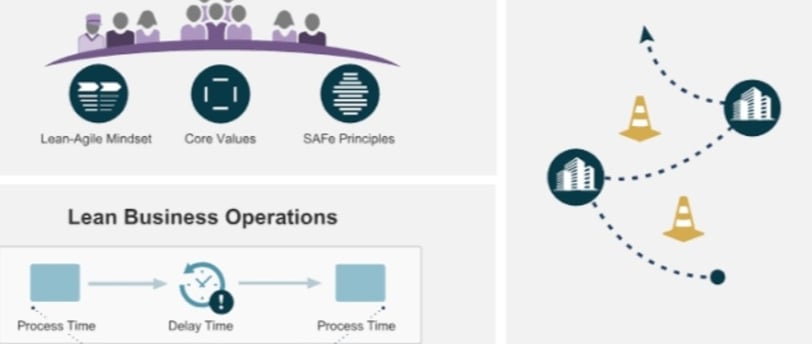Strategic and Leadership Agility:
- Q: Can you describe your experience with organizational transformation towards Agile methodologies?
- A: Lead Agile transformation projects, measuring success through increased delivery speed, customer satisfaction, and employee engagement.
- Q: Share an experience where you had to lead a team or organization through a significant change. How did you apply Agile principles to manage this change?
- A: Implemented Agile change management by advocating for iterative changes, actively involving stakeholders, and maintaining flexibility to feedback.
- Q: How do you balance the need for process and structure with the Agile value of individuals and interactions over processes and tools?
- A: Championed customizing Agile frameworks to fit team dynamics while maintaining core Agile values, ensuring processes aid, not impede, team collaboration.
- Q: As a leader, how would you handle resistance to Agile adoption from senior team members or other departments within the organization?
- A: Addressed resistance by presenting case studies of Agile success, engaging resistors in the process, and demonstrating quick wins to build momentum.
- Q: How do you ensure that Agile practices do not become just a set of rituals, but continue to add value to the organization?
- A: Encouraged continuous learning and flexibility in Agile practices, ensuring they're tailored to deliver real business value and not just followed ceremonially.
Scaled Agile Framework (SAFe) Specific:
- Q: Can you describe your experience with Scaled Agile Framework?
- A: Rolled out SAFe in a multinational corporation, scaling Agile practices across 100+ teams and establishing feedback loops for continual improvement.
- Q: How would you go about assessing the maturity of a SAFe implementation, and what metrics would you use?
- A: Assessed SAFe maturity by evaluating predictability, adaptability, and improvement frequency, using quantitative metrics such as cycle time and release frequency.
- Q: SAFe emphasizes alignment, built-in quality, transparency, and program execution. Can you provide an example of how you have promoted each of these in a previous role?
- A: Fostered alignment through PI Planning, ensured quality with automated testing and CI/CD pipelines, promoted transparency with information radiators, and oversaw program execution via consistent retrospectives.
- Q: In your view, what are the most significant challenges when scaling Agile across multiple teams or departments and how have you addressed them?
- A: Overcame challenges such as inter-team dependencies and differing Agile maturity levels by implementing cross-functional Scrum of Scrums and tailored training programs.
Operational Excellence and Continuous Improvement:
- Q: How do you foster a culture of continuous improvement within an Agile environment?
- A: Established a blame-free culture that values experimentation and learning from mistakes, leading to more proactive problem-solving and innovation.
- Q: Discuss a time when you had to adapt or update Agile practices to suit the evolving needs of an organization. What change was made, and why?
- A: Integrated DevOps with Agile process to streamline product development and operations, resulting in 40% faster feedback loops and reduced time-to-market.
- Q: What approaches or techniques have you used to measure the effectiveness of Agile teams, and how have you used this data to improve performance?
- A: Utilized velocity tracking, burn-down charts, and team satisfaction surveys, translating insights into actionable items for performance enhancement.
Coaching and Mentoring:
- Q: Explain how you have mentored other leaders or Agile coaches in your previous positions. What areas did you focus on, and what outcomes did you see?
- A: Mentored leaders on servant leadership and Agile mindset, resulting in a 25% increase in team autonomy and a significant improvement in employee satisfaction scores.
- Q: As a senior leader, how do you ensure that Agile coaches and Scrum Masters in your organization continue to grow and develop?
- A: Supported continuous professional development through workshops, certifications, and cross-training, which resulted in a demonstrable increase in team performance metrics.
- Q: Can you talk about a time when you helped a team move from a low level of Agile maturity to a high level? What coaching techniques did you use, and what were the results?
- A: Applied targeted coaching, regular training, and facilitated communities of practice, moving a team from ad-hoc processes to a high-functioning Agile unit with a 50% improvement in production deployments.
Vision and Alignment:
- Q: How do you align multiple Agile teams with the organization’s strategic goals to ensure they are building the right product?
- A: Created a clear vision roadmap and utilized artefacts like Epic User Stories to ensure team efforts directly support strategic objectives.
- Q: Describe your approach to setting, communicating, and achieving strategic goals within an Agile framework.
- A: Utilized OKRs to set and communicate high-level objectives, ensuring team backlogs and sprint goals align with these corporate milestones.
- Q: How do you involve and align stakeholders with different interests and levels of understanding of Agile during the decision-making process?
- A: Promoted stakeholder engagement through interactive planning sessions, regular demos, and ensuring a shared understanding of Agile principles and b


